MARPISSA
(the town center is only 500 meters from the apartments see map 1)
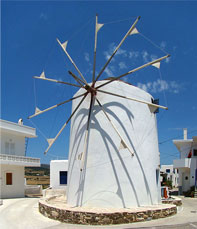
Marpissa is located high on the hills of Paros. It is a beautiful village, with the Sculpture Museum of Perantinos, its mills and its coastal settlement, Piso Livadi, with fish taverns and bars.
Marpissa is also one of the most beautiful villages of Paros. It is located at the top of a small hill, at the center of which there is the dominating church of Metamorphosis (the Transfiguration of Jesus), of byzantine style. Close by, there is the Museum of Perantinos and a bit further down, the monument of Stellas.
At the small square of the village, there are the four characteristic windmills of Paros and here is also the starting point of a path that leads to the monastery of Agios Antonios (St. Anthony). The view from the summit of Kefalos, where the monastery is located, is wonderful. The Aegean Sea lies at your feet.
The village's houses (dating back to the 16th and 17th century) and its paved alleys are beautiful. It is located 17 kilometers to the east of Parikia, 40 meters from sea level. Marpissa's former name was Tsipidos. It is built amphitheatrically, with taverns and cafés and at the village's square there is the Folklore Museum with interesting exhibits.
If you happen to be at the village on Good Friday you will be impressed by the representation of the Passion of Christ, while on Easter Sunday there is a traditional Greek feast.

Map 1 • Town Center

Map 2 • St Antonios Monastery
Piso Livadi & Logaras are only 500 meters away
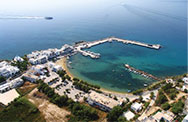
If you pass through Marpissa and you cross a small pinewood, you will arrive in Piso Livadi. At its small picturesque port there are taverns with exceptional dishes to taste with your ouzo and lively bars. There is also a small beach with big salt cedars that is ideal for swimming.During the summer months, there are boats that depart from the picturesque port of Piso Livadi to Naxos, Ios, Santorini, Amorgos, Mykonos, Delos, Antiparos and Koufonissia. The ticket for those who want to go on an excursion off Paros is quite cheap. The church of Agios Georgios Thalassitis with its numerous frescos is a pole of attraction for tourists.
The beach of Logaras is located on the south-eastern side of Paros and it has been awarded the European Union’s blue flag. Its rich seabed is a pole of attraction for the lovers of harpooning. The beach has many salt cedars that provide shelter from the hot sun. At the area of Logaras, there are restaurants and cafés.
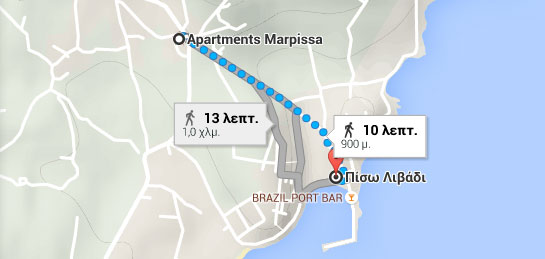
Map 3 • Piso Livadi

Map 4 • Logaras
Molos, Kalogeros (the clay beach) & Pounta Beach - Beaches Near Us
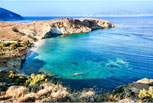
On the eastern side of Paros, there is the bay of Molos and the homonymous village. It is a big sandy beach with crystal clean waters, ideal for families with kids, with salt cedars, fine sand and a view of Naxos. The beach and the village are located between the hills of Kefalos and Antikefalos and according to the archeologists, the ancient city of Yria was once situated in this area.The entire area of Molos is integrated into theNATURA 2000 network, due to its natural beauty.In Molos, there are restaurants and taverns, where you can enjoy the traditional dishes of Paros.
The village of Pounta is situated on the eastern side of Paros and it has a large sandy beach. It is characterized by its much-frequented bars, which attract thousands of young people, who choose Paros to spend their vacation.The access is easy and it is located close to the beach of Logaras. It has been awarded the European Union's blue flag.
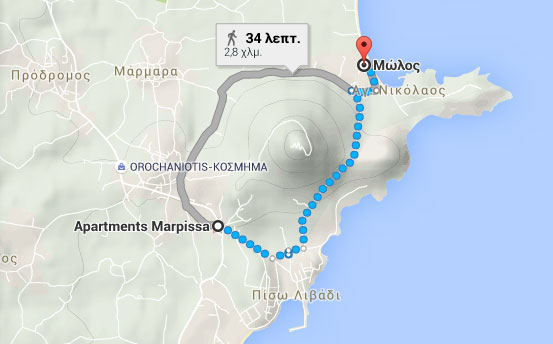
Map 5 • Molos beach

Map 6 • Kalogeros beach
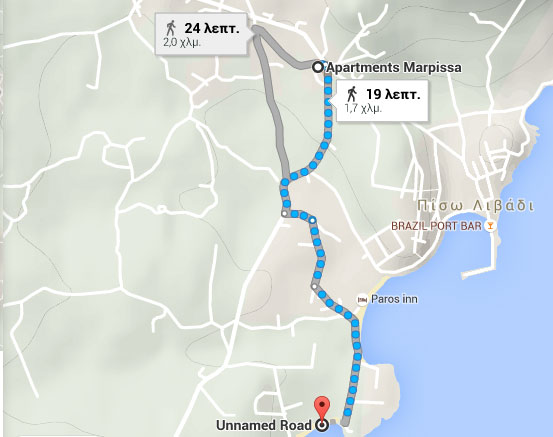
Map 7 • Pounda beach
Other places to visit...
LEFKES
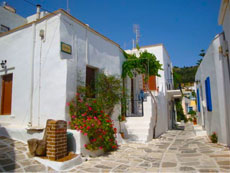
It is the most mountainous village of Paros and the most verdurous one. Lefkes was the first capital of Paros. The village is located under a pinewood on the hill. A walk around its beautiful narrow streets with the white joints will impress you. You will see the old washhouses that are still used by certain housewives, the House of Literature, the picturesque Ramnos, a street with taverns and other stores and the wonderful view: the sea and Naxos in the background.The houses are built amphitheatrically. The first residents were immigrants that came from Crete and Naoussa and locals who chose to built their village on the mountain, in order to be protected from the pirates.Ramnos, the central street of the village is located among neoclassic buildings, the school, the former community building and the House of Literature. 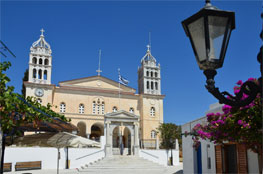 The Parians and the visitors of Paros take their walk along this street or they go to the stores of the area and to the cafeterias at the small square, where the war memorial is situated. On the hills around the village there are windmills, many of which have been restored and at the edge of the village, on a hill, there is the church of Agia Triadawith the famous belfries that have been recently restored.Lefkes is the most verdurous village of Paros; that is why if you take a walk in its streets or visit its many churches you will hear cicadas and at nightfall crickets and screech owls. The village attracts many tourists during the summer months. The feast of Karavolas is held in Lefkes among various events that are organized by the cultural association YRIA. The feast of Karavolas is an opportunity of the Lefkians to celebrate the end of summer. The date when it is held is not fixed, it takes place at the end of August and it is organized every year by the Cultural Association of Lefkes MEAS Yria. The Parians and the visitors of Paros take their walk along this street or they go to the stores of the area and to the cafeterias at the small square, where the war memorial is situated. On the hills around the village there are windmills, many of which have been restored and at the edge of the village, on a hill, there is the church of Agia Triadawith the famous belfries that have been recently restored.Lefkes is the most verdurous village of Paros; that is why if you take a walk in its streets or visit its many churches you will hear cicadas and at nightfall crickets and screech owls. The village attracts many tourists during the summer months. The feast of Karavolas is held in Lefkes among various events that are organized by the cultural association YRIA. The feast of Karavolas is an opportunity of the Lefkians to celebrate the end of summer. The date when it is held is not fixed, it takes place at the end of August and it is organized every year by the Cultural Association of Lefkes MEAS Yria.
At the festival there is food such as karavoles (big snails), garlic sauce, string beans, traditional cheeses, chick peas in the oven and of course lots of wine. It is the most important feast of the village and it keeps going till the small hours, since there is also traditional music! If you happen to be in Paros at the time, it is worth visiting Lefkes and going to the festival of Karavolas.All transport in Lefkes is on foot. There are two parking lots at the entrance of the village, where you can park your vehicle. Walking around the paved alleys of the village is an exceptional experience. Limy stone benches, buildings of folklore architecture, bougainvilleas in almost all houses and various other plants and flowers. In Lefkes it is also worth visiting theFolklore Museum of Cycladic Civilization.
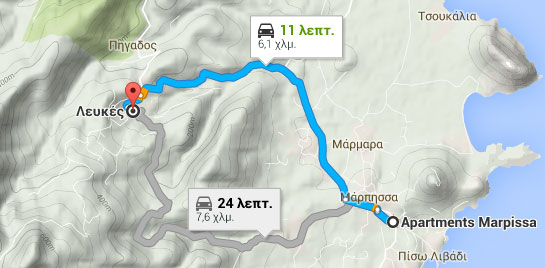
Map 8 • Lefkes village
ASPRO CHORIO & DRIOS

Aspro Horio is located at the valley over the beach of Lolantonis and a little further down, there is Drios, which combines the mountain and the sea. Here, you will find beautiful taverns on the beach and in the village and a view of the big blue of the sea.
Drios is located 25 kilometers from Parikia and it has a long history. During the ancient times it was Paros' port because there was water to supply the battleships and the merchant ships with. You can still see the parallel grooves, which were carved by the ships that were dragged out of the sea. According to another version, the grooves were made by the wheeled wagons, in which they used to transport the Parian marble to load it on ships.Drios is rich in vegetation and it has a beautiful beach with nice taverns over it.At the village you can visit the ancient ship sheds (places where they used to shelter ships) and the cave of demons with stalagmites and stalactites, the lakes of Drios etc.
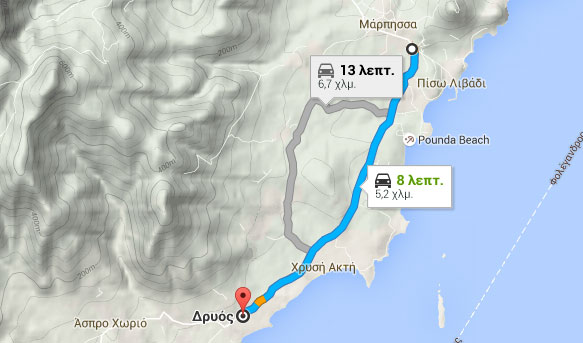
Map 9 • Drios
NAOUSSA
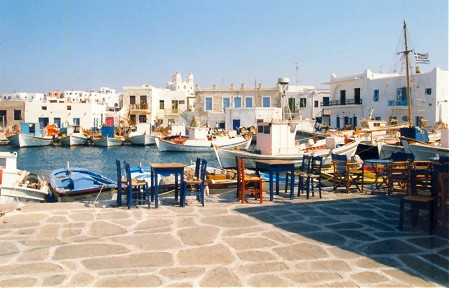
Picturesque alleys and the Venetian castle on the beach, illuminated at nigh, add a magical note to the scenery, in combination with the marina and the small and big boats, fishing boats or yachts. Entertainment in Naoussa lasts till the small hours since there are all kinds of places to go.
The city is built amphitheatrically at the second biggest bay of Paros, with the port and the marina and it has played an important role since the times of the Komnenos dynasty.
In 1650 – 1700, the French came to the island and they created a school to impose to the residents the catholic religion. However, they failed as did the Venetians three centuries before them.
In 1770 Naoussa becomes a Russian naval base and the Russians establish their headquarters on the islet Agia Kali, at the center of the bay of Naoussa. At the port there is also a small castle called "Kasteli", which was built by the Venetians. A big part of the castle is preserved. Close to the castle, by the sea there is the church of St. Nicolaos, the patron saint of sailors and fishermen, since in Naoussa there are still many fishing boats.On the port there are taverns, bars, cafeterias,restaurants and on its renovated square with the tall eucalyptuses you will also find all kinds of stores, a playground and the church of Pantanassa.
On the village's hill there is the church of the Assumption, which is visible from all the sides of the city. The picturesque river meets the sea after passing under a beautiful bridge, which is a real jewel of Naoussa and of Paros.
In the summer, in Naoussa, this picturesque city of Paros, there is a fish festival and many other events, such as the feast for the nine days after the Assumption of the Virgin Mary, on the 23 of August.
At the bay where the monastery of St. John Detis is situated, right opposite to Naoussa and at the wider area, there is the Environmental – Cultural Park of Paros, which is worth visiting.
Naoussa is a traditional fishermen village since it has the biggest fleet of fishing boats in Cyclades. It is located at the northern coasts of Paros and its port hosts all the fishing boats of the village, while the marina offers hospitality to all kinds of yachts.
In Naoussa you will find various stores, bars, cafeterias, taverns, restaurants and places specialized in small dishes to accompany your drink.
There are also numerous wonderful beaches: Piperaki, Piperi, Monastiri, Kolimpithres, Santa Maria, Lageri.
In Naoussa you can also visit important monuments: ancient settlements (Koukounaria hill), a proto-Cycladic cemetery (Plastiras) and the Venetian fortress at the northern side of the port.
Around Naoussa there are also monasteries where the visitor can admire elaborate temples and frescos. Those are the monastery of St. John Detis, the monastery of Saint Athanassios, the medieval church of Saint George.
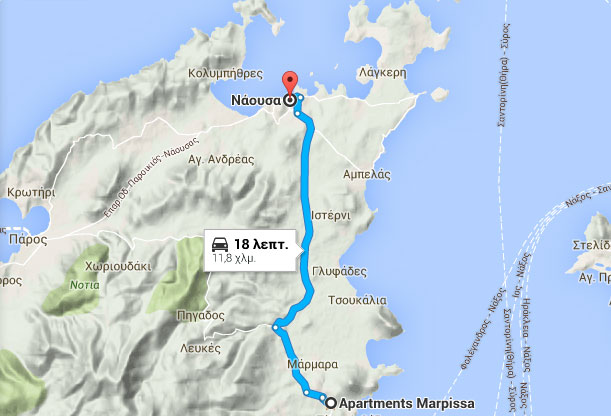
Map 10 • Naoussa
PARIKIA
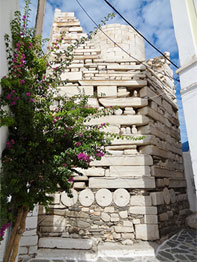
The capital of Paros with the passenger and the commercial port and the Mill, which is the trademark of the village, is located at the island’s bay.
There are beautiful settlements in Parikia, however Parikia itself will also fascinate you if you take a walk around its alleys.
Ekatontapiliani and the pinewood next to it, the Venetian castle in the old market, the church of Agios Constantinos (St. Constantine), the hill of Agia Anna (St. Anna) with its two mills, which are a trademark of Paros and are soon going to be restored, the perennial palm trees on the street along the coast (Giannis Parios st.) and all kinds of stores attract the visitors.
In Parikia, the port of Paros, ships come and go all year long but mainly from spring and through summer, carrying people and goods.
This city of Paros has been inhabited since the prehistoric times but in the 13th century, when it took its current form, the Venetians build the castle on the hill inside the city. Many of the parts of the ancient temple of Demeter have been used for the construction of this castle. In this part of the city, in Kastro (the Castle), there are houses and small churches (St. Mark, St. Anna, St. Stylianos), while a bit higher on the hill there is the church of St. Constantine, a Byzantine monument of Paros. From the hill and from the street along the coast (Giannis Parios st.) in Parikia you can enjoy a wonderful sunset, maybe the most beautiful sunset in Paros.
4 km. to the southwest of Parikia, there is the Valley of the Butterflies, a verdurous biotope of Paros, where you will see Tiger moth butterflies.
Food is not going to be a problem in Parikia. There are places where you can taste a variety of small dishes with your drink, taverns, traditional and international cuisine restaurants.
When it comes to entertainment there are also many choices; cafés, bars, live music stages, clubs etc., where you can party till the small hours.
There are also many beautiful beaches that are located near Parikia such as Livadia, the beach in front of the Nautical Club of Paros, Krios, Agios Fokas, Delfini and Parasporos.
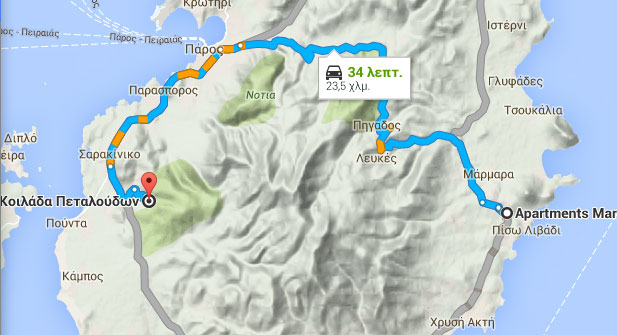
Map 11 • Parikia
ALIKI
Aliki is a beautiful fishermen village with a picturesque port, taverns and the beach Piso Aliki with white pebbles and salt cedars that spread down to the sea. Aliki is located at the southern part of Paros and it took its name from the salt-marsh (in greek: aliki) that is located at the edge of the village.
At its beautiful taverns you can try fresh fish and the traditional gouna(mackerel dried in the sun).
Next to the small port, there is one more beautiful beach, which is ideal for swimming in its crystal clear blue waters.There is also the large beach with the deep blue waters at Piso Aliki, with pebbles and salt cedars as well as the beach of Faragas, with its four beautiful bays.
In Aliki you will find, bars, a playground as well as football, basketball and volleyball fields.
Not far from the entrance of Aliki, you will find Paros’ airport.
In Aliki there is also the Cycladic Folklore Museum of the self-taught artist M. Skiadas.Many cultural events are held in Aliki such as the feast of St. John of Klidonas in June, the feast of Christ the Savior on the 6th of August and the feast of the Holy Cross on the 14th of September.
Walk around the streets and alleys that lead from Aliki to Agairia. Agairia is a semi-mountainous picturesque settlement, about 3 km. from the sea.
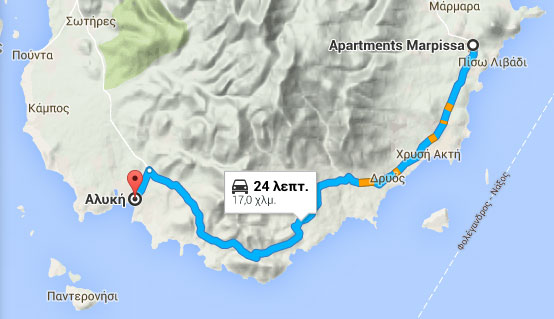
Map 12 • Aliki
|

